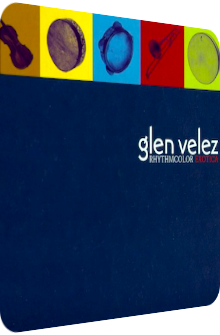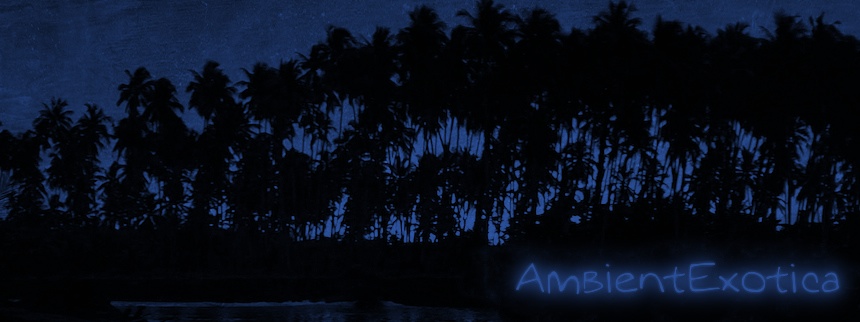
Glen Velez
Rhythmcolor Exotica
1997
Glen Velez (born 1949) is a multi-instrumentalist who focuses on the drum-related sides in the world of music, and so his works are hard to narrow down, gyring around New Age valleys, Latin lands and faraway deserts. An album with the name of Rhythmcolor Exotica should – one would hope – encapsulate the quintessence of the versatile musician’s way of life and aesthetic viewpoints. Released in 1997 on Ellipsis Arts and sporting nine unique movements, the instrumental base comprises of several different drums whose lush dream-like easiness is then projected onto rubicund strings of the Oriental kind and decidedly Western trombone inclusions, although there are many tracks that only feature drums and chants. There is that certain danger of deriding Rhythmcolor Exotica as a World music leftover of the esoteric kind, but there are Latin rhythms hidden in the parallax layers alright.
Featuring the talent of trombonist and Duke Ellington band member Art Baron as well as the Handance Ensemble complete with their exquisite collection of exotic drums (among them a Celitic bodhrain and Moroccan bendir), Velez is keen on contrasting the East with the West, but making it so that those contrasts are multiplexed and streamlined. The result is what one could describe as mellow, and even though the alienating tone sequences and textures of the drums are unknown and, well, perfectly exotic, vivacity is not what Velez has in mind. The dry deserts and clandestine places are not historic or cinematic, but still entertaining. What else Glen Velez’s Rhythmcolor Exotica gains and lacks from an Exotica fan’s perspective is observed below.
Golden Seal makes for a splendid start and carves out the realm of Rhythmcolor Exotica sufficiently. Oscillating between post-colonial realism and fantastic Exotica, the song focuses on the polyphony of Middle Eastern lutes and their pizzicato counterparts, but of ewual importance is the riq drum of Egyptian origin. The textures of the drum concoctions is dry, the saffron heatwave is further fueled by the snake charmer flute. The plasticity is then boosted in the adjacent Pan Eros which feigns a Latin Blues qua Art Baron’s commonplace trombone solo and Glen Velez’s own staccato toasts. Soon enough however, surrealism prospers and flows as wonderfully monotonous gourds lure the listener closer to the ever-present proximity of the four-note lute which is aglow in sunset-red colors. The pressure – or presence – of the drums is augmented in the second phase, but the soothing maraca strata provide a mellow counterpoint. While the wittily titled Velez Rubio is an unexpectedly melancholic legato peritoneum whose nostalgic strings and doleful current is the album’s utmost contemplative inclusion, the long-form journey Mesopotamia has it all, at least percussion-wise: from bouncing guiro-like cricket-esque dialogs over mild-mannered drum-accentuated synergies to Space-Age sermons, melodies are reduced to a minimum in this robinsonade.
Meanwhile, Rosanna’s Turquoise reintroduces melodious elements into the refreshing drum rivulet. The saxophone inherits Occidental tone sequences that remind of the enigmatic saxophonic visions of Sabu’s Safari (1958), but thankfully the rufescent violins provide a feminine allure and transform this shuffling piece into a laid-back diorama. The drum pericarp Temple Of Moonlight is seamlessly attached to the mellowness, but ventures into comparatively dramatic drum solos. The surface, however, doesn’t hurt, nor is it intimidating due to the bouncy verve that is attached to the decay. The centerpiece Procession For Bes is yet another long percussion panorama that runs for over 12 minutes. Melodies are again sternly reduced, only the distant vocals add some sort of interdependency amidst the orderly coppice of riqs, rattles and rhizomes. Afterwards, Tecolote interpolates the African spirit by featuring a viscid kalimba in-between the viridian-naïve alto flute airflows and dusky luminescence of the strings before Doorway To Dionysus marks the endpoint of the journey. The instrumental pool is cautiously widened, and so is the stylistic heritage: clicking castanets, Indian jungle flutes, hypnotizing drum patterns and silvery-alkaloidal shakers round off the distinct mélange.
The title of Rhythmcolor Exotica unravels, on closer inspection, the two primary forces that grace the album. It doesn’t need a genius to point out the focus on polyrhythmic cataracts and Middle Eastern transfigurations that are spawned by the world of Exotica. However, these two styles are neither equalized, nor do they annihilate the distinctive flavor. The real Exotica aficionado will probably be disappointed by Glen Velez’s interpretation of the beloved genre alloy, but then again, this album is released in 1997, so it is maybe ruled out in its entirety due to its year of release alone.
Whatever the reason, Rhythmcolor Exotica achieves something that not many drum or percussion albums are able to, not even the genre standards of the late 50’s and early 60’s when the percussion craze was at its peak: a refreshing easiness. Velez doesn’t need to proof his skills on various drums, and neither do the other musicians feel the need to feature their respective signature instrument overly prominently. The equilibrance is always a given, the serration of the textures is the actual focal point. This and the fact that Middle Eastern melodies are presented lead to the conclusion that Rhythmcolor Exotica isn’t as colorful, let alone exotic as advertised if one expects the usual flamboyancy of this alloy. The soothingness, however, remains key and ultimately makes Velez’s album a great entry in the percussion roster. It is available on CD, as a digital download and on streaming services.
Exotica Review 401: Glen Velez – Rhythmcolor Exotica (1997). Originally published on Dec. 27, 2014 at AmbientExotica.com.
